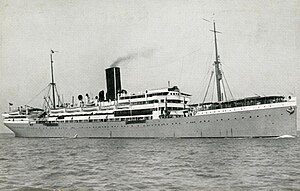 Nyassa
| |
| History | |
|---|---|
| Name |
|
| Namesake |
|
| Owner |
|
| Operator | 1916: Transportes Mar do Estado |
| Port of registry | |
| Route |
|
| Builder | Joh. C. Tecklenborg, Bremerhaven |
| Yard number | 209 |
| Launched | 21 April 1906 |
| Completed | 22 September 1906 |
| Out of service | laid up 1922–24; 1950–51 |
| Identification |
|
| Fate | scrapped 1951 |
| General characteristics | |
| Class and type | "General"-class mail steamship |
| Tonnage | 8,965 GRT, 5,034 NRT |
| Length | 462.4 ft (140.9 m) |
| Beam | 57.6 ft (17.6 m) |
| Depth | 36.0 ft (11.0 m) |
| Decks | 4 |
| Installed power | 760 NHP; 6,500 ihp |
| Propulsion |
|
| Speed | 15 knots (28 km/h) |
| Capacity |
|
| Crew | 194 |
| Sensors and processing systems |
|
SS Nyassa was a steam ocean liner that was launched in Germany in 1906 as Bülow for Norddeutscher Lloyd (NDL). In 1916 Portugal seized her, renamed her Trás-os-Montes, and placed her under the management of Transportes Marítimos do Estado (TME). In 1924 Companhia Nacional de Navegação (CNN) bought her and renamed her Nyassa. After a long career with CNN she was scrapped in England in 1951.
As Bülow, the ship sailed mostly between Bremen and the Far East. However, she spent 1907 making three return voyages between Bremen and Sydney, and in 1908 she made at least three return voyages between Bremen and New York.
As Nyassa, her scheduled route was between Lisbon and Moçambique via Cape Town. In 1941 she rescued survivors from a British merchant ship that had been sunk by a U-boat. From 1940 to 1944 she made numerous voyages taking refugees from Portugal, Spain, and Morocco to the United States, Argentina, Brazil, Cuba, the Dominican Republic, Mexico, and Palestine.